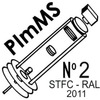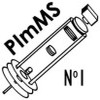MenuApplicationsSpatial Imaging of Chemical Compounds Velocity Mapping Coincidence Imaging Molecular Motion Tissue Imaging DevelopmentFast Scintillators Direct Ion Detection |
Time Resolved Molecular Motion-- In collaboration with Henrik Stapelfeldt at the Femtolab, Aarhus Universitet, Denmark
Another application of the PImMS camera to velocity-map imaging is in the measurement of correlations between photoions. In collaboration with the group of Henrik Stapelfeldt at the University of Aarhus, the PImMS camera has been used to measure correlations between the trajectories of ions resulting from the Coulomb explosion of a biphenyl molecule. The multi-mass imaging capabilities of the PImMS camera allow the measurement of correlations between a large number of different ions, including H+, C+, N+, F+, and Br+. The correlated ion trajectories, measured through a covariance analysis of the data, reveal much about the molecular structure and of the Coulomb explosion dynamics. The structural information provided through the measurement of ion trajectory correlations has also been used as a probe to follow the induced torsional motion between the two carbon rings in a biphenyl molecule. The torsional motion is first initiated using a fs 'kick' laser pulse, followed a short time later (ps) by a much more intense 'probe' laser pulse, which Coulomb explodes the molecules. By measuring correlations between F+ and Br+ ion trajectories using the PImMS camera we were able to follow the motion of the molecule out to 200ps, watching the two rings periodically rocking back and forth. Related Publications |




